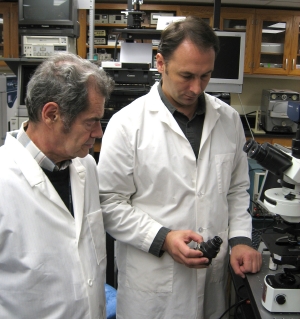Apr 22 2008
Auburn University researchers have built a rechargeable microscope illumination system for NASA scientists who are using it during Antarctic expeditions.

Professor Vitaly Vodyanoy and research assistant Oleg Pustovyy of the AU Department of Anatomy, Physiology and Pharmacology built the patent-pending Ilumna 120 to help NASA scientists observe microscopic life in areas where there is no electricity. NASA used it on a preliminary, 11-day trip in February and will take it in November for three months during the Tawani Foundation International 2008 Schirmacher Oasis Antarctica Expedition.
The device, which contains a battery pack, condenser and bulb with a built-in collimator, attaches to standard research microscopes, producing high-resolution images. It measures 3 inches high, 2 inches wide and 2.25 inches deep. For the NASA scientists, it is attached to a microscope that previously used sunlight and a mirror when electricity was not available.
“This one is brighter and does not depend on the weather,” Vodyanoy said. “The condenser produces annular (ring-shaped) illumination, so they can see smaller objects better. They can see small bacteria now.”
The Ilumna 120 can be powered by either a 110- or 220-volt outlet in normal laboratory conditions; by the internal, rechargeable nine-volt, lithium ion battery pack during field trips; or by recharging the battery pack through a solar element for environments away from electricity. It also can operate on three standard three-volt batteries.
“The internal parts are not really new,” Vodyanoy said. “We used a commercial condenser and bulb that has a built-in collimation lens. There were other devices on the market, but they did not fit the microscope very well and are not designed to work with high resolution microscopes.”
NASA scientists used the Ilumna 120 on a reconnaissance expedition to the Schirmacher Oasis, Antarctica, in February to study microbial life forms, called extremophiles, that survive and sometime thrive in some of the most hostile conditions on the planet. The trip allowed them to assess requirements for the main, upcoming expedition to the Schirmacher Oasis and Lake Untersee in November.
“The extremely cold, dry and windy conditions of the great white desert of Antarctica provide the best terrestrial analog for conditions that may exist on Mars and other frozen worlds of our solar system,” said Richard Hoover, astrobiology group leader at NASA’s Marshall Space Flight Center and National Space Science and Technology Center in Huntsville.
“Although penguins, a few other bird species and fur seals can thrive at the margins of the Antarctica continent, microbial extremophiles are the only kinds of life found in the interior,” Hoover said.
Hoover and his team are working on the isolation, characterization and scientific description of several exotic and novel microbial extremophiles found in samples of guano of African penguins and from an ice cave and several lakes. They also are using the Ilumna 120 system to explore the characteristics of a new extremophile species and a new genus of bacteria from samples of Magellanic penguin guano that Hoover collected with astronaut James Lovell during the Antarctica 2000 Expedition.
“The Ilumna 120 system coupled to my Leitz microscope and Sony video camera was found to be ideally suited for high resolution studies of the detailed morphology and locomotion of the extremely small polar microorganisms discovered during the Schirmacher Oasis Expedition,” Hoover said.
Vodyanoy says the Ilumna 120 has other potential research and medical applications, such as in pathogenic disease detection, geology studies, military uses in the battlefield and during outbreaks and disasters when electricity is not available. It would be useful, he says, in underdeveloped countries and in isolated agricultural areas.
“Samples may die on the way to the lab, so the Ilumna 120 could help medical researchers have more capabilities in remote areas,” Vodyanoy said.
His research assistant, Pustovyy, built the device in December, working “day and night” during the holiday break to complete the project. “NASA needed it in a hurry, so we were able to put it together quickly so they could get familiar with it before their trip,” Pustovyy said.
Vodyanoy said, “His [Pustovyy’s] role was crucial in getting it completed in time for the expedition. NASA needed it by the end of December so they would have time to test it.”